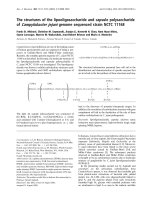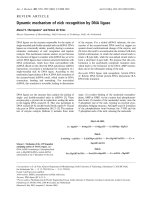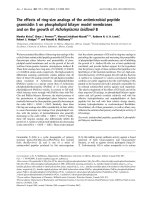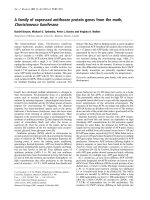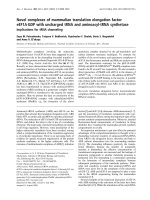Báo cáo Y học: Histidine mutagenesis of Arabidopsis thaliana pyruvate dehydrogenase kinase ppt
Bạn đang xem bản rút gọn của tài liệu. Xem và tải ngay bản đầy đủ của tài liệu tại đây (201.2 KB, 6 trang )
Histidine mutagenesis of
Arabidopsis thaliana
pyruvate
dehydrogenase kinase
Alejandro Tovar-Mendez
1
, Jan A. Miernyk
1,2
and Douglas D. Randall
1
1
Department of Biochemistry, University of Missouri, Columbia, MO 65211, USA;
2
USDA, Agricultural Research Service,
Plant Genetics Research Unit, Columbia, MO 65211, USA
Pyruvate dehydrogenase kinase (PDK) is the primary
regulator of flux through the mitochondrial pyruvate dehy-
drogenase complex (PDC). Analysis of the primary amino-
acid sequences of PDK from various sources reveals that
these enzymes include the five domains characteristic of
prokaryotic two-component His-kinases, despite the fact
that PDK exclusively phosphorylates Ser residues in the E1a
subunit of the PDC. This seeming contradiction might be
resolved if the PDK-catalyzed reaction employed a phos-
pho-His intermediate. The results from pH-stability studies
of autophosphorylated Arabidopsis thaliana PDK did not
provide any support for a phospho-His intermediate. Fur-
thermore, site-directed mutagenesis of the two most likely
phosphotransfer His residues (H121 and H168) did not
abolish either PDK autophosphorylation or the ability to
transphosphorylate E1a. Thus, PDK is a unique type of
protein kinase having a His-kinase-like sequence but Ser-
kinase activity.
Keywords: autophosphorylation; protein kinase; pyruvate
dehydrogenase complex; regulatory phosphorylation; site-
directed mutagenesis.
The reaction catalyzed by the pyruvate dehydrogenase
complex (PDC) occupies a key position in intermediary
metabolism, and is subject to multiple layers of regulation
[1,2]. Reversible phosphorylation is a particularly important
control mechanism for mitochondrial PDC [3,4]. Multisite
serine phosphorylation of the E1a subunit of PDC by the
intrinsic pyruvate dehydrogenase kinase (PDK) inactivates
the complex, which can then be re-activated by an intrinsic
phosphopyruvate dehydrogenase phosphatase [5]. Steady-
state activity of the PDC is determined by the sum of the
PDK and phosphopyruvate dehydrogenase phosphatase
reactions.
Sequence analysis and biochemical characterization have
shown that phosphopyruvate dehydrogenase phosphatase is
a unique member of the type 2C class of phosphoprotein
phosphatases [6,7]. In contrast, however, PDK, and the
closely related branched-chain a-ketoacid dehydrogenase
kinase (BCKDK), remain enigmatic. Despite exclusively
phosphorylating Ser residues in the E1a subunits of the target
complexes, these kinase sequences lack motifs typically
conserved in protein Ser/Thr-kinases [8–10]. Instead, they
include the cardinal motifs of protein His-kinases (PHKs)
[11]. In addition, site-directed mutagenesis of conserved
amino-acid residues within the N, D, F and G boxes of
PHKs has confirmed that these motifs comprise the catalytic
domain [12–14]. These motifs are located in the C-terminal
region of PDK, as with PHKs, with the presumptive H box
distal to the catalytic domain [15]. In addition to the sequence
resemblance to PHKs, treatment with His-directed reagents
inactivated PDK [16]. However, mutagenesis of the con-
served His121 residue, a potential site of His autophos-
phorylation, did not abolish PDK activity [17].
Autophosphorylation has been reported for PDKs from
several sources [17–19]. It has been determined that one or
more Ser residues near the N-terminus of PDK, and the
closely related BCKDK, are autophosphorylated. Surpris-
ingly, however, this Ser phosphorylation seems to be stable;
the phosphate is not transferred to E1a [17,19]. If, in
addition to Ser autophosphorylation, there was also His
autophosphorylation, it would not have been detected in
previous experiments [17]. The most simple interpretation of
the existing data is that PDK is a protein Ser-kinase (PSK)
with a phospho-His catalytic intermediate. The experiments
described here were designed to test this hypothesis.
Four His residues are conserved among PDK sequences
from various organisms; His121, His168, His231
,
and
His233 [numbered according to the Arabidopsis thaliana
(AtPDK) sequence] [20]. His121, is 40 residues N-terminal
to the H box, His168 is within the H box, and His231 and
His233 are immediately N-terminal to the N box. It has
been established that His233 co-operates with Glu238 in
acting as a general base catalyst in the PDK reaction [12].
We report the results of pH-stability studies, which indicate
that there is not a phospho-His reaction intermediate. In
addition, the activity of AtPDK was not abolished by the
H121Q mutation, the H168Q mutation, or the H121Q/
H168Q double mutation. Thus, despite the sequence
resemblance to PHKs, PDK does not have a phospho-His
intermediate and is instead a unique type of PSK.
Correspondence to D. D. Randall, Department of Biochemistry,
Schweitzer Hall, University of Missouri, Columbia, MO 65211, USA.
Fax: + 1 573 882 5635, Tel.: + 1 573 882 4847,
E-mail:
Abbreviations: AtPDK, Arabidopsis thaliana pyruvate dehydrogenase
kinase; BCKDK, branched-chain a-ketoacid dehydrogenase kinase;
E1, pyruvate dehydrogenase; kd-PDC, kinase-depleted pyruvate
dehydrogenase complex; MBP, maltose-binding protein; PDC,
pyruvate dehydrogenase complex; PDK, pyruvate dehydrogenase
kinase; PHK, protein histidine-kinase; PSK, protein serine-kinase.
Note: a web page is available at />(Received 6 February 2002, revised 4 April 2002,
accepted 15 April 2002)
Eur. J. Biochem. 269, 2601–2606 (2002) Ó FEBS 2002 doi:10.1046/j.1432-1033.2002.02933.x
MATERIALS AND METHODS
Reagents
Restriction endonucleases were from New England Biolabs
(Beverly, MA, USA). PCR primers were from Integrated
DNA Technology, Inc. (Coralville, IA, USA). Unless
otherwise noted, reagents were provided by the Sigma
Chemical Company (St Louis, MO, USA).
In silico
analyses
Amino-acid sequences were retrieved from the National
Center for Biotechnology Information web page (http://
www.ncbi.nlm.nih.gov/). Sequences were initially aligned
using
PHYLIP
[21], and the alignments polished manually. For
phylogenetic comparisons, the AtPDK amino-acid sequence
wasusedasthequeryfora
BLAST
[22] search of the NCBI
database. The resulting sequences were aligned with
PHYLIP
,
then subjected to 500 rounds of bootstrap analysis using the
SEQBOOT
function of
DNAMAN
(version 2.71; Lynnon
BioSoft, Vaudreui, Quebec, Canada). The phylogenetic tree
was constructed using
TREEVIEW
[23]. Secondary-structure-
based phylogenetic comparisons were conducted using
PSI
-
BLAST
[24] coupled to GenTHREADER [25].
Bacterial expression and purification of maltose-binding
protein (MBP)–AtPDK
MBP–AtPDK was expressed and purified as described
previously [17]. After affinity purification, the protein was
concentrated using an ultrafiltration membrane with a
10-kDa cut-off (Amicon, Beverly, MA, USA), then stored
in aliquots at )20 °C.
Site-directed mutagenesis
The AtPDK reading frame, previously cloned into pMal-
cRI [17], was used as the template for mutagenesis. The
BamHI–PstI fragment containing the sequence that encodes
the C-terminal half of AtPDK (G160 to P366) was PCR-
amplified using primers DDR229 (5¢-ctcgagctgcagctat
taTCGGGTAAAGGCTCTTGCGA-3¢) and DDR 309
(5¢-CGAATCGGGATCCGGATGCTTATTGGGCAGC
AAGTTGAGTTGCAT-3¢). The DDR309 primer includes
the H168Q mutation (the base changed is in bold). Thermal
cycling was conducted using the ACCUZYME DNA
polymerase (Midwest Scientific, St Louis, MO, USA). The
PCR product was inserted into pGEM-3Zf(+) and
sequenced to verify the H168Q mutation and that no
additional changes had been introduced. The H168Q
C-terminus fragment was then transferred to pBluescript II
SK+. The N-terminus (XbaI–BamHI fragment) of either
the wild-type (wt) or the H121Q AtPDK sequence was then
ligated to the pBluescript H168Q C-terminus, generating
an ORF encoding the H168Q or H121/168Q AtPDK
mutants. These constructs were transferred to pMal-cRI for
expression.
Phosphorylation/inactivation of the PDC
Activity of the PDC was measured spectrophotometrically
as the increase in A
340
due to reduction of NAD
+
[26]. As a
substrate for recombinant PDK, kinase-depleted (kd)-PDC
was prepared from purified pea seedling mitochondria as
described previously [27]. For phosphorylation assays,
MBP–AtPDK was incubated with kd-PDC for 5 min at
25 °C, then reaction was initiated by adding [c-
32
P]ATP
(Perkin Elmer Life Sciences; 2.2 TBqÆmmol
)1
). Reactions
were stopped by adding an equal volume of 2 · sample
buffer [8
M
urea, 4% (w/v) SDS, 4% (v/v) 2-mercaptoeth-
anol, 10 m
M
EDTA] followed by heating at 70 °Cfor
20 min. Proteins were resolved by SDS/PAGE, transferred
to nitrocellulose membranes, then examined by autoradio-
graphy. Incorporation of
32
P into proteins was quantified by
liquid-scintillation spectrometry of excised bands.
ATPase activity was assayed essentially as described in
[12], using [c-
32
P]ATP as the substrate. The
32
P
i
released from
ATP was quantified by liquid-scintillation spectrometry.
Determination of the pH stability
of autophosphorylated AtPDK
To investigate which amino-acid residues were involved,
1.4 lg of either wild-type MBP–PDK or the H121Q/
H168Q mutant protein was autophosphorylated with
[c-
32
P]ATP, resolved by SDS/PAGE, transferred to
poly(vinylidene difluoride) membranes (Millipore Corp.).
The membranes were treated with 50 m
M
KCl/HCl, pH 1,
100 m
M
Tris/HCl, pH 7, or 1
M
NaOH, pH 14, in the
presence of 10% methanol for 2 h at 45 °C. Radioactivity
was then quantified by liquid-scintillation spectrometry of
the corresponding excised bands. In parallel with AtPDK,
Escherichia coli CheA was autophosphorylated for use as a
bona fide PHK control.
RESULTS
Alignment of the AtPDK sequence with those of orthologs
from maize, mouse, and Ascaris suum reveals substantial
primary sequence conservation (Fig. 1). Sequence identity is
notably high within the H, N, D, and G boxes, which
comprise the cardinal motifs of PHKs (Fig. 1). When the
AtPDK sequence was used as the search term in
BLAST
analysis of GenBank, the only sequences retrieved that had
significant E-values (<0.026) were those of other PDKs, the
closely related BCKDKs, and several signal-transducing
PHKs. Significance was determined using the student’s
2-tailed t test. The phylogenetic relationships among these
sequences are presented in Fig. 2. Similar results were
obtained when predicted secondary structures were used for
comparisons (data not presented).
From the results of previous analyses, it was concluded
that both native and recombinant PDK autophosphory-
late Ser residues. The methods used, however, would not
have specifically detected the occurrence of phospho-His.
To re-evaluate this question, AtPDK was autophosphor-
ylated using [c-
32
P]ATP, then subjected to acidic (pH 1),
neutral (pH 7), or alkaline (pH 14) treatment before
quantitative analysis. The E. coli CheA protein, a PHK
involved in chemotaxis, was included as a control. The
32
P
labeling of AtPDK was acid-stabile but alkali-labile
(Fig. 3). The extent of
32
P incorporation into the AtPDK
H121Q/H168Q mutant protein was much lower than with
the wild-type protein; however, the pattern of pH stability
was identical. Under the same experimental conditions,
2602 A. Tovar-Mendez et al.(Eur. J. Biochem. 269) Ó FEBS 2002
labeling of CheA was, as expected, alkali-stable and
acid-labile.
Recombinant AtPDK was capable of both time-depend-
ent inactivation of kd-PDC (Fig. 4) and incorporation of
radioactivity from [c-
32
P]ATP into E1a (Fig. 5).
The kd-PDC used as the substrate for PDK had virtually
no associated kinase activity. Residual PDC activity after a
60-min incubation in vitro was essentially identical with or
without MgATP (Fig. 4). The H121Q/H168Q mutant of
MBP–AtPDK inactivated kd-PDC less rapidly than did
wild-type MBP–AtPDK (Fig. 4), although, if assays were
extended, the same end-point was ultimately reached (data
not presented). Whereas the MBP–AtPDK chimera had full
catalytic capability, removal of the fusion partner increased
the rate of PDC inactivation approximately fourfold. The
lower rate of the mutant kinase was more pronounced when
tested as the MBP fusion.
Mutagenesis of conserved residues His121 and His168
differentially affected autophosphorylation and trans-
phosphorylation of E1a (Fig. 5). The AtPDK H121Q
mutant displayed an 80% reduction in the extent of
autophosphorylation after 5 min, but had only a small
effect on transphosophorylation of E1a. Similar results were
obtained in experiments of longer duration. The H168Q
mutant had less inhibition of autophosphorylation but
more of transphosphorylation (Fig. 5). Inhibition of both
autophosphorylation and transphosphorylation by the
H121/168Q double mutant was approximately additive.
In contrast with a previous report of low-level ATPase
activity of rat PDK2 [12], we were unable to detect any
significant hydrolysis of ATP to ADP plus P
i
by AtPDK
(data not shown). The recombinant enzyme preparations
used for ATPase assays were, however, fully capable of
inactivating kd-PDC. It is not clear if the previously
reported ATPase activity was the result of a minor
contaminant, or if this result indicates an actual difference
between the rat and A. thaliana enzymes. This possibility
seems unlikely, considering the extent of protein sequence
conservation.
DISCUSSION
A prominent regulatory mechanism for the mitochondrial
PDC is multisite serine phosphorylation [2–5]; thus, PDK is
a PSK. The domains that define PSK enzymes include 12
conserved subdomains which fold into a common catalytic
core structure [8]. After cloning and sequence analysis,
however, it was clear that mammalian PDK lacks the
AtPDK MAVKKACEMFPKSLIEDVHKWGCMKQTGVSLRYM MEFGSKPTERNLLISAQFLHKELP
ZmPDK2 MASEPVARAVAEEVARWGAMRQTGVSLRYM MEFGARPTERTLLLAAQFLHKELP
MmPDK2 MRWVRALLKNASLAGAPKYIEHFSKFSPSPLSMKQFLDFGSSNACEKTSF TFLRQELP
AsPDK MFLTRRLLGPFTSAIARKLEHYSQFQPSSLTIQQYLDFGQTGTMKSSFL FLKNELL
consensus L + ++FG+ T + +L FL++ELP
IRVARRAIELQTLPYGLSDKPAVLKVRDWYLESFRDMRAF PEIKDSGDEKDFTQ
IRIARRALDLDSLPFGLSTKPAILKVKDWYVESFREIRSF PEVRNQKDELAFTQ
VRLANIMKEINLLPDRVLGTPSVQLVQSWYVQSLLDIMEF LDKDPEDHRTLSQFTDAL
VRLANIMQEISLLPPTLLKMPSRRLVSNWYCESFEDLLQFEHAQVEPDIMSKFNDQLQTI
+R+A+ E+ LP +L P++ V WY+ESF D+ F PE+ + T
MIKAVKVRHNNVVPMMALGVNQLKK GMN SGNLDEIHQ-FLDRFYLSRIGIRMLIG
MIKMIRVRHTNVVPAIALGVQQLKKDLGGPKAFPPGIHEIHQ-FLDRFYMSRIGIRMLIG
VT IRNRHNDVVPTMAQGVLEYKDTYGDD PVSNQNI-QYFLDRFYLSRISIRMLIN
L— KRHSRVVETMAEGLIELRESEGVD IASERGI-QYFLDRFYINRISIRMLQN
+ ++ RH +VVP+MA GV LK G + + I Q FLDRFY+SRI+IRMLI
______
QHVELHNP NP PLHTVGYIHTKMSPMEVARNASEDARSICFREYGSAPEINIYGDPS
QHVALHDPD P-EPGVI-GLINTKMSPMTVARIASEDARAICMREYGSSPDVDIYGDPG
QHTLIFDGSTNPAHPKHI-GSIDPNCSVSDVVKDAYDMAKLLCDKYYMASPDLEIQ-EVN
QHLVVF-GVVLPESPRHI-GCIDPGCDVESVVHDAYENARFLCERYYLTAPGMKL EMH
QH+ + P P HI G I + S V + A E AR +C R Y ++P++ I +
H-box
_
FTFP–-YV PTHL-HLMMYELVKNSLRAVQERFVDSDRVAPPIRIIVADGIEDVT
FTFPYVTP-HL-HLMIFELVKNSLRAVQERYMDSDKLAPPVRIIVADGAEDVT
-ATNANQPIHMVYVPSHLYHML-FELFKNAMRATVESHESSLTL-PPIKIMVALGEEDLS
NSVNPGMPISIVAVPSHLYHIM-FELFKNSMRATVENHGADEDL-PPIKVMVVRGAEDLS
P +V P+HL H+M FEL+KNS+RA E S+ L PPI+I+VA GAED++
N-box
D-box-
IKVSDEGGGIARSGLPRIFTYLYSTARNPLEEDVDLGIADVPVTMAGYGYGLPISRLYAR
IKISDEGGGIPRSGLSRIFTYLYSTAENPPD LDGHNEG-VTMAGYGYGIPISRLYAR
IKMSDRGGGVPLRRIERLFSYMYSTAPTPQPGTGG TPLAGFGYGLPISRLYAK
IKISDRGGGVSRTILDRLFTYMYSTAPPPPRDGTQPP LAGYGYGLPLSRLYAR
IK+SD GGG+ R+ L RIFTY+YSTA P +AGYGYGLPISRLYAR
G1-box G2-box
YFGGDLQIISMEGYGTDAYLHL-SRLGDSQEPLP
YFGGDLQIISMEGYGTDAYLHL-SRLGDSEEPLP
YFQGDLQLFSMEGFGTDAVIYLKALSTDSVERLPVYNKSAWRHHYQTIQEAGDWCVPSTE
YFHGDMYLVSMEGYGTDAMIFLKAIPVEASEVLPIYSTSSRRQLTMSPQAADWSHQLPNH
YF GDLQ++SMEGYGTDA++ L + DS E LP
PKNTSTYRVS
GNRNL
Fig. 1. Comparison of selected PDK sequences.
At, A. thaliana PDK (GI:4049631); Zm,
Zea mays PDK2 (GI:3695005); Mm, Mus
musculus PDK2; As, Ascaris suum PKD
(GI:1945392). The sequences were aligned
using
PHYLIP
[21], then the alignments were
optimized manually. The conserved His
residues are shown in bold. The locations of
sequences corresponding to the five cardinal
motifs of PHKs [11,15] are indicated by
underlines. When at least three residues belong
to the same family, the consensus is indicated
as (+).
Ó FEBS 2002 A. thaliana pyruvate dehydrogenase kinase (Eur. J. Biochem. 269) 2603
defining domain organization of PSKs [9]. Instead PDK
sequences include the five canonical domains (H, N, D, G1,
and G1 boxes) of PHKs [11,15]. It was subsequently found
that this same organization is shared by mammalian,
nematode [28], fly [29], and plant (Figs 1 and 2) [10] PDK
sequences, as well as those of the related BCKDKs [19].
Thus, PDK is a conundrum. The results from primary
sequence analysis and at least some biochemical experi-
ments [16] are consistent with PDK as a PHK. At the same
time, it has been unequivocally established that PDK
phosphorylates multiple Ser residues in the E1a regulatory
target. The simplest resolution of these apparent contradic-
tions would be the occurrence of phospho-His as a reaction
intermediate. This, however, does not seem to be the case.
Previous analyses employed pH conditions that would
not have allowed detection of the transient occurrence of
phospho-His. We directly addressed this by incubating
AtPDK with [c-
32
P]ATP and then determining the stability
of the resultant phosphoenzyme. Recombinant CheA was
included in these assays as a PHK control. From previous
results [17] we expected that most of the radiolabel in
AtPDK would be acid-stable phospho-Ser. This was the
case, and we observed no significant alkali-stable labeling of
pH1
Radioactivity (cpm x 10
3
)
0
3
6
9
12
15
CheA wild-type
H121Q/ H168Q
MBP-AtPDK
pH7
pH14
Fig. 3. Effect of pH on the stability of AtPDK autophosphorylated using
[c-
32
P]ATP. Approximately 1.4 lg wild-type or the H121Q/H168Q
mutant of MBP–AtPDK, or E. coli CheA, was incubated with 2 pmol
Mg[c-
32
P]ATP (0.22 TBqÆpmol
)1
) for 1 h at 25 °C. After SDS/PAGE,
the proteins were transferred to poly(vinylidene difluoride) mem-
branes, which were then treated with 50 m
M
KCl/HCl(pH 1),100m
M
Tris/HCl (pH 7), or 1
M
NaOH (pH 14) in the presence of 10% (v/v)
methanol for 2 h at 45 °C. The radiolabeled proteins were detected by
autoradiography, and the bands excised and quantified by liquid-
scintillation spectrometry.
Relative PDC activity
0
0.2
0.4
0.6
0.8
1.0
0
Time (min)
10 20 30 40 50
60
Fig. 4. Inactivation of kd-PDC by AtPDK. All assay mixtures con-
tained 45 lg kd-PDC and 20 l
M
MgATP. Assays contained 53 lg
MBP–AtPDK (wt and mutant) or 13 lg AtPDK (wt or mutant). At
the indicated time points, samples were taken for spectrophotometric
assay of PDC activity. (n)+ATP;(m) – ATP + MBP–AtPDK; (j)
+ ATP + MBP–AtPDK; (d) + ATP + MBP–AtPDK H121Q/
H168Q; (h) + ATP + AtPDK; (s) + ATP + AtPDK H121Q/
H168Q. Data are representative results.
0.1
Sp-PDK
Mm-BCKDK
Nc-BCKDK
Ec-SHK
Ss-SHK
Am-SHK
Sc-SHK
Bh-SHK
St-SHK
At-PDK
Zm-PDK2
As-PDK
Dm-PDK
Mm-PDK
Fig. 2. Phylogenetic relationships among PDKs, BCKDKs, and sensor
histidine kinases (SHK). Sp, Schizosaccharomyces pombe (GI:7708590);
Mm, M. musculus BCKDK (GI:6753164); Nc, Neurospora crassa
(GI:12718471); Ec, E. coli BaeS (GI:2507376); Ss, Synechocystis sp.
(strain PCC 6803) SHK (GI:7469378); Am, Amycolatopsis mediterra-
nei kA SHK (GI:7339510); Sc, Streptomyces coelicolor SHK
(GI:7799270); Bh, Bacillus halodurans ResE (GI:15614144); St, Strep-
tococcus thermophilus Hpk2 (GI:13324643); At, A. thaliana PDK
(GI:4049631); Zm, Z. mays PDK2 (GI:3695005); As, A. suum PDK
(GI:1945392); Dm, Drosophila melanogaster PDK (GI:7303893); Mm,
M. musculus PDK2 (GI:8096763). The sequences were aligned using
PHYLIP
,thenanalyzedwith
SEQBOOT
(500 rounds of bootstrapping).
The scale bar corresponds to the number of substitutions per site. The
tree was constructed using TreeView.
2604 A. Tovar-Mendez et al.(Eur. J. Biochem. 269) Ó FEBS 2002
AtPDK, although this was seen with the CheA control. The
method used for these analyses does not yield an all or
nothing result, so it is not possible to unequivocally state
that there is not a phospho-His intermediate, although the
results do not support this possibility.
The phospho-His contingency was further addressed
using site-directed mutagenesis. Four His residues are
conserved among PDK sequences; His121, His168,
His231, and His233 (numbered according to the A. thaliana
PDK sequence [20]). It has been established that His233
co-operates with Glu238 in acting as a general base catalyst
in the PDK reaction [12], so we discounted His231 or His233
as sites for His autophosphorylation. The remaining possi-
bilities are His121 and His168, which are upstream of and
within the H box, respectively. If one of these His residues
were a site of autophosphorylation, it would be expected
that mutagenesis would inactivate AtPDK. Although the
H121Q, H168Q, and H121Q/H168Q mutant proteins had
reduced PDK activity, they were each capable of both
autophosphorylation and transphosphorylation of E1a.
At this point, the function of Ser autophosphorylation in
PDK activity is unclear, although it has been reported with
PDKs from several sources [17–19]. Ser autophosphoryla-
tion is apparently stable, and the phosphate group is not
subsequently transferred to E1a [17,19]. The His mutagen-
esis of AtPDK had distinct effects on autophosphorylation
and transphosphorylation of E1a. It seemed possible that
the apparently different effects were an artefact arising from
differential phosphorylation of the recombinant proteins
during bacterial expression. This possibility was tested by
adding
32
P
i
to bacterial cultures before induction of AtPDK
synthesis. However, none of the resulting AtPDK proteins,
wild-type or any of the His mutants, showed any
32
P
labeling. Thus the role of Ser autophosphorylation remains
enigmatic, although the results with the His mutant AtPDK
proteins further support dissociation of autophosphoryla-
tion from transphosphorylation of PDC.
While this manuscript was in preparation, the structure of
ADP-ligated rat PDK2 was solved at 2.5 A
˚
resolution [30].
The crystallographic data support earlier sequence-based
structural predictions that PDK is a member of the PHK/
ATPase superfamily [14]. The authors conclude that
His115 (His121 in AtPDK) is not solvent accessible, and
is involved in important structural hydrogen bonds within
the N-terminal domain [30]. Thus, despite the sequence
similarity to PHKs, results from both structural analyses
and use of site-directed mutagenesis argue against any role
for His phosphorylation in the PDK reaction.
ACKNOWLEDGEMENTS
G. L. Hazelbauer generously provided recombinant E. coli CheA. This
research was supported by National Science Foundation grant IBN-
9876680, the Missouri Agricultural Experiment Station, and the Food
for 21st Century Program.
REFERENCES
1. Reed, L.J. (2001) A trail of research from lipoic acid to a-keto acid
dehydrogenase complexes. J. Biol. Chem. 276, 38329–38336.
2. Mooney, B., Miernyk, J.A. & Randall, D.D. (2002) The complex
fate of a-ketoacids. Annu. Rev. Plant Physiol. Plant Mol. Biol. 53,
357–375.
3. Korotchkina, L.G. & Patel, M.S. (2001) Site specificity of four
pyruvate dehydrogenase kinase isoenzymes toward the three
phosphorylation sites of human pyruvate dehydrogenase. J. Biol.
Chem. 276, 37223–37229.
4. Kolobova, E., Tuganova, A., Boulatnikov, I. & Popov, K.M.
(2001) Regulation of pyruvate dehydrogenase activity through
phosphorylation at multiple sites. Biochem. J. 358, 69–77.
5. Roche,T.E.,Baker,J.C.,Yan,X.,Hiromasa,Y.,Gong,X.,Peng,
T., Dong, J., Turkan, A. & Kasten, S.A. (2001) Distinct regulatory
properties of pyruvate dehydrogenase kinase and phosphatase
isoforms. Prog. Nucleic Acid Res. Mol. Biol. 70, 33–75.
6. Lawson,J.E.,Niu,X.D.,Browning,K.S.,Trong,H.L.,Yan,J.&
Reed, L.J. (1993) Molecular cloning and expression of the catalytic
subunit of bovine pyruvate dehydrogenase phosphatase and
sequence similarity with protein phosphatase 2C. Biochemistry 32,
8987–8993.
7. Das,A.K.,Helps,N.R.,Cohen,P.T.&Barford,D.(1996)Crystal
structure of the protein serine/threonine phosphatase 2C at 2.0 A
˚
resolution. EMBO J. 15, 6798–6809.
8. Hanks, K. & Hunter, T. (1995) Protein kinases 6. The eukaryotic
protein kinase superfamily: kinase (catalytic) domain structure
and classification. FASEB J. 9, 576–596.
9. Harris, R.A., Popov, K.M., Zhao, Y., Kedishvili, N.Y.,
Shimomura, Y. & Crabb, D.W. (1995) A new family of protein
kinases-the mitochondrial protein kinases. Adv. Enzyme Regul. 35,
147–162.
10. Thelen,J.J.,Muszynski,M.G.,Miernyk,J.A.&Randall,D.D.
(1998) Molecular analysis of two pyruvate dehydrogenase kinases
from maize. J. Biol. Chem. 273, 26618–26623.
11. Stock, A.M., Robinson, V.L. & Goudreau, P.N. (2000) Two-
component signal transduction. Annu. Rev. Biochem. 69, 183–215.
kDa
97.6
66
45
29
MBP-AtPD
K
E1α
H121Q
H168Q
H121Q/
H168Q
wt
A
B
Relative incorporation
0
0.2
0.4
0.6
0.8
1.0
wt H121Q
H168Q
H121Q/
H168Q
E1α
MBP-AtPDK
Fig. 5. Autophosphorylation of MBP–AtPDK and transphosphoryla-
tion of PDC E1a. (A) 3 lg kd-PDC was incubated with 1 lgMBP–
AtPDK plus 200 l
M
Mg[c-
32
P]ATP (18 GBqÆmmol
)1
)for5minat
25 °C. A set of representative autoradiographs are presented. (B)
Relative incorporation of
32
PintoMBP–AtPDKorE1a. Data are
means ± SD from three independent enzyme preparations. The same
patterns of results were obtained using either 1.5 or 6 lgofMBP–
AtPDK.
Ó FEBS 2002 A. thaliana pyruvate dehydrogenase kinase (Eur. J. Biochem. 269) 2605
12. Tuganova, A., Yoder, M.D. & Popov, K.M. (2001) An essential
role of Glu-243 and His-239 in the phosphotransfer reaction cat-
alyzed by pyruvate dehydrogenase kinase. J. Biol. Chem. 276,
17994–17999.
13. Wynn, R.M., Chuang, J.L., Cote, C.D. & Chuang, D.T. (2000)
Tetrameric assembly and conservation in the ATP-binding
domain of rat branched-chain alpha-ketoacid dehydrogenase
kinase. J. Biol. Chem. 275, 30512–30519.
14. Bowker-Kinley, M. & Popov, K.M. (1999) Evidence that pyruvate
dehydrogenase kinase belongs to the ATPase/kinase superfamily.
Biochem. J. 344, 47–53.
15. West, A.H. & Stock, A.M. (2001) Histidine kinases and response
regulator proteins in two-component signaling systems. Trends
Biochem. Sci. 26, 369–376.
16.Mooney,B.P.,David,N.R.,Thelen,J.J.,Miernyk,J.A.&
Randall, D.D. (2000) Histidine modifying agents abolish pyruvate
dehydrogenase kinase activity. Biochem. Biophys. Res. Commun.
267, 500–503.
17. Thelen, J.J., Miernyk, J.A. & Randall, D.D. (2000) Pyruvate
dehydrogenase kinase from Arabidopsis thaliana:aproteinhisti-
dine kinase that phosphorylates serine residues. Biochem. J. 349,
195–201.
18. Jackson, J.C., Vinluan, C.C., Dragland, C.J., Sundararajan, V.,
Yan,B.,Gounarides,J.S.,Nirmala,N.R.,Topiol,S.,Ramage,P.,
Blume, J.E., Aicher, T.D., Bell, P.A. & Mann, W.R. (1998)
Heterologously expressed inner lipoyl domain of dihydrolipoyl
acetyltransferase inhibits ATP-dependent inactivation of pyruvate
dehydrogenase complex. Identification of important amino acid
residues. Biochem. J. 334, 703–711.
19. Davie, J.R., Wynn, R.M., Meng, M., Huang, Y.S., Aalund, G.,
Chuang, D.T. & Lau, K.S. (1995) Expression and characterization
of branched-chain alpha-ketoacid dehydrogenase kinase from the
rat. Is it a histidine-protein kinase? J. Biol. Chem. 270, 19861–
19867.
20. Thelen, J.J., Miernyk, J.A. & Randall, D.D. (1998) Nucleotide
and deduced amino acid sequences of the pyruvate dehydrogenase
kinase from Arabidopsis thaliana (accession, AF039406) (PGR
98–192). Plant Physiol. 118, 1533.
21. Felsenstein, J. (1989) PHYLIP-Phylogeny Inference Package
Version 3.2. Cladistics 5, 164–166.
22. Altschul, S.F., Gish, W., Miller, W., Myers, E.W. & Lipman, D.J.
(1990) Basic local alignment search tool. J. Mol. Biol. 215,403–
410.
23. Page, R.D. (1996) TreeView: an application to display phylo-
genetic trees on personal computers. Comput. Appl. Biosci. 12,
357–358.
24. Altschul,S.F.,Madden,T.L.,Schaffer,A.A.,Zhang,J.,Zhang,Z.,
Miller, W. & Lipman, D.J. (1997) Gapped BLAST and PSI-
BLAST: a new generation of protein database search programs.
Nucleic Acids Res. 25, 3389–3402.
25. Jones, D.T. (1999) GenTHREADER: an efficient and reliable
protein fold recognition method for genomic sequences. J. Mol.
Biol. 287, 797–815.
26. Miernyk, J.A. & Randall, D.D. (1987) Some kinetic and reg-
ulatory properties of the pea mitochondrial pyruvate dehy-
drogenase complex. Plant Physiol. 83, 306–310.
27. Thelen, J.J., Miernyk, J.A. & Randall, D.D. (1998) Partial pur-
ification and characterization of the maize mitochondrial pyruvate
dehydrogenase complex. Plant Physiol. 116, 1443–1450.
28. Chen, W., Huang, X., Komuniecki, P.R. & Komuniecki, R.
(1998) Molecular cloning, functional expression, and character-
ization of pyruvate dehydrogenase kinase from anaerobic muscle
of the parasitic nematode Ascaris suum. Arch. Biochem. Biophys.
353, 181–189.
29. Katsube, T., Nomoto, S., Togashi, S., Ueda, R., Kobayashi, M. &
Takahisa, M. (1997) Sequence and expression of a gene encoding a
pyruvate dehydrogenase kinase homolog of Drosophila melano-
gaster. DNA Cell Biol. 16, 335–339.
30. Steussy, C.N., Popov, K.M., Bowker-Kinley, M.M., Sloan, R.B.
Jr, Harris, R.A. & Hamilton, J.A. (2001) Structure of pyruvate
dehydrogenase kinase. Novel folding pattern for a serine protein
kinase. J. Biol. Chem. 276, 37443–37450.
2606 A. Tovar-Mendez et al.(Eur. J. Biochem. 269) Ó FEBS 2002



